A delightfully bouncy and cheerfully lovely friend came down to visit Los Angeles for the weekend recently, and we had more then one adventure. Having company from out of town always puts me in a different mindset and state of being then when I am in LA visitor free. It inspires excitement and bouts of energy to do everything fun I can possibly squeeze in to the time they are visiting for. So let’s rewind back to the weekend all of the following happened, and hit play!
Part 1: James Turrel @ LACMA
The first thing on the agenda was a visit to LACMA to see the James Turrell exhibit. Per their website description: “James Turrell: A Retrospective explores nearly fifty years in the career of James Turrell (b. 1943, Los Angeles), a key artist in the Southern California Light and Space movement of the 1960s and 70s. The exhibition includes early geometric light projections, prints and drawings, installations exploring sensory deprivation and seemingly unmodulated fields of colored light, and recent two-dimensional work with holograms. One section is devoted to the Turrell masterwork in process, Roden Crater, a site-specific intervention into the landscape just outside Flagstaff, Arizona, presented through models, plans, photographs, and films.” (Source & link to purchase tickets here, they are around $27ea)
The tickets to this have set times and need to be purchased in advance, as it is so incredible they have to schedule it out this way in 30 minute increments. In my personal opinion, and that of all those I have spoken to who have seen it, it is quite worth it. If you are in LA now or before April 6th of 2014 when it closes, I highly recommend seeing it. He uses… I didn’t even understand what most of the time. You think it’s just a white square projected on the wall in the corner, but it looks like a 3-D cube of light floating out towards you. Part of you sees a flat perspective projection situation, yet your childlike dreamer eyes see a white lit box with two sides resting against the wall. It is amazing, and I can see my architect friend picking apart this first and every piece thereafter differently then I, in ways I can’t imagine or understand. It’s so beautiful to watch other people appreciate art, especially other artists whose minds are specially wired for their specific crafts.
Afrum – White 1966 Turrell (image source)
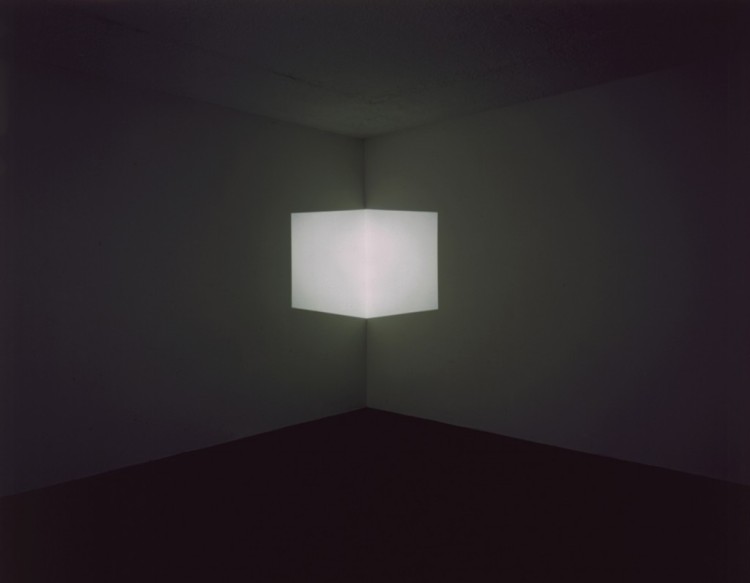
A few rooms later, there are holographic light recordings on to pieces of glass. They seem to come out at you in what looks to be a single shape of multiple colors, that you should be able to tangibly touch. I don’t understand. How do you record light, to make this 3-D hologram, on a piece of clear glass?! It’s astounding and bewildering, and it opens you up in new ways just to let your mind take it in. I am quite sure (but open to being corrected if I am wrong) that it is not possible to photograph these holographs in a way to show you here what I experienced there. There is no google search you or I can do to show what I saw with my eyes, nor what I experienced in the hall of colorful light holograms.
Holograms (image source)
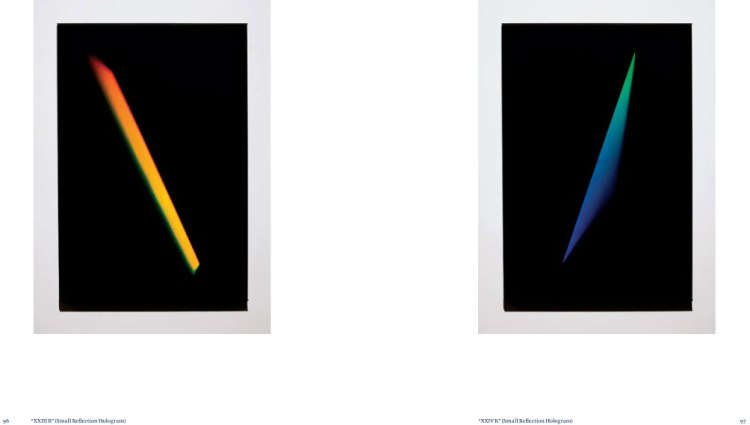
One of my favorite parts came a few rooms later, in what I lovingly refer to as ‘the pink room’. If you’ve seen the exhibit, you know which one I am talking about. I told my friend it was my new happy place. He asked what I meant. I explained that whenever I get stressed out, I like to imagine myself in a place that I’ve found a certain comfort and peace in before. It was so wonderful there, so I memorized the feeling of my calm being and the surrounding pink glowing; how it felt, what it looked like, and I stored it away for later use. Then, whenever I find myself privy to one of life’s dealings of sickness, dissatisfaction or disappointment, I can go to my happy place to escape that pain. I can just bring that happy place comfort to the present moment, and calm myself down to a state of acceptance. The pink room, or Raemer Pink White, at the James Turrell exhibit, is a new happy place.
Raemer Pink White 1969 – Turrell (image source)

Later on, there is this really dark room that you have to tread so slow and lightly all the way to get in. It’s that dark. Inside are these semi transparent laser walls of light, 3 of them at different angles and of different colors. It was as if they led to another dimension. There was this internal angst that I felt, as if I was on the edge of another world I wouldn’t see for fear of stepping through and not being able to come back. It looked as though it was an illusion, like the walls were made by laser beams only, and that I could ultimately walk through. At the same time in the extreme light deprivation darkness of the room, they looked like real walls. I sensed within myself a subconscious internal emotional torment. On one hand, I so badly wanted to try to walk through to what must be the place where the answers are. On the other hand, there was the sense of having to obey the rules of tangible earthly existence in that these walls would stop me, because they were real; they existed and my physical form could not permeate past. It was entertaining to watch my mind, my imagination, my senses and my primitive natural instincts flare up and react together and against each other within this created environment. It’s just some simple lights in a dark room, right?
Wedgeworks, Key Lime – Turrell (image source)
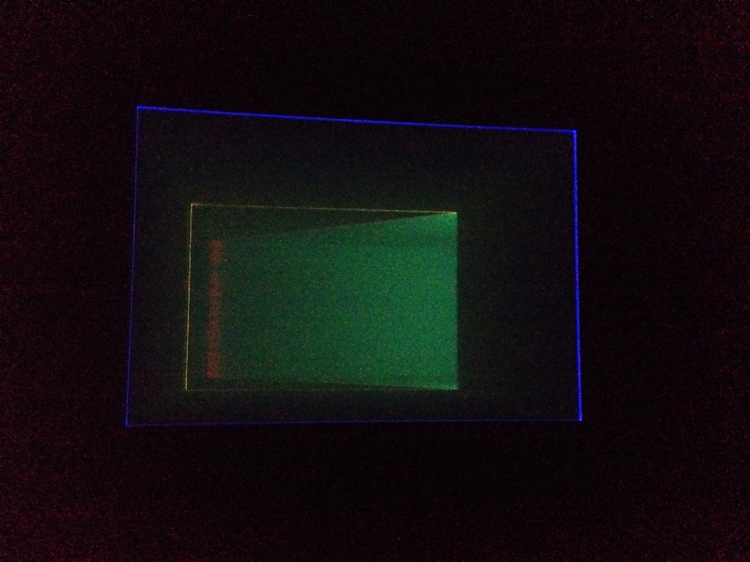
There is a room at the start of the second Turrell section, where you have to remove your shoes and put fabric booties over your socks. This is because you are going to go in to an all white room, and they don’t want what your worldly wandering shoes have picked up getting the floors dirty. You are about to enter a space where you will be submersed in light as you would be submerged in water were you to jump in the ocean. There are dark stairs leading up to a room that seems to start from, and go, to no where. The walls of the entrance/opening blend back to the middle walls inside, and those to the back wall.
Once you enter, that opening will be gone behind you, and the museum man will warn you not to go too far forward, or else you will fall off the edge. There is a drop at the far end, he tells us. Ahead of us it is so perfectly curved that I can’t tell where the floor meets the wall, or any of the walls for that matter. With a subtle artistic lack of angles and slight shifts in perspective, the room is a big rounded blank white canvas. I’m in shapeless undefined space, and every piece of the whole, except for me, is now glowing. Soft pinks, bright burning red and beautiful unreal eyes blue. WHITE, a very clean and healing white. So many colors, I just stood, gazed, and let it happen around me. It is an interesting feeling to see solid light but no shape in all visual directions.
Ganzfeld, Breathing Light Entrance | Turrell (image source)

Much of this exhibit turned out to be pieces of my new happy place actually. They inspired me to states of silent appreciation and awe. I won’t be discarding my previous happy places though, but rather just add to the collection, like my favorite books lining the shelf for future use when needed. Different happy places are like different playlists to me, most effective when used at the appropriate times for the given mood and situation. For this glorious James Turrell exhibit at LACMA, I put together a little playlist suited to my mind’s journey back there whenever life dictates I need a revisit.
Light Rooms Equal Happy Places:
“Lalibela” by Caribou
“Within Dreams” by The Album Leaf
“Open” by Rhye
“Blame Them” by Blackbear feat James Blake
“Pull Me Down” by Mikky Ekko
“Afterglow” by Phaeleh feat Soundmouse
“Obedear” by Purity Ring
“Let It Be” by Blackmill feat Veela
“Stepson” by Foals
“Dove Season” by In the Valley Below
“Papertrails” by Darkside
“Hanging On” by Active Child
“Insane” by Flume feat Moon Holiday
“Alone” by JMSN
“Butterfly” by Bassnectar feat Mimi Page
“Neon Moon” by Kasabian
At the end, you learn about James Turrell’s current (ongoing) project- he bought a crater in the middle of no where, and is building an incredible art exhibit station. From Turrell’s website on the matter, Michael Govan tells it well:
“It is a volcanic crater located in an area of exposed geology, the Painted Desert, an area where you feel geologic time. You have a strong feeling of standing on the surface of the planet.” —James Turrell
Roden Crater is a natural cinder volcano situated on the southwestern edge of the Painted Desert in Northern Arizona. Since 1972 James Turrell has been transforming the crater into a large-scale artwork that relates, through the medium of light, to the universe of the surrounding sky, land and culture.
Organized as a distinct set of changing experiences of light, Turrell’s intervention in the natural form of Roden Crater consists of a series of chambers, pathways, tunnels, and openings onto the sky from within and around the crater’s surface.
The artist’s subtle refinement of the natural shape of the crater bowl held 400 feet above the horizon alters the viewer’s perception of the sky. Certain chambers within the crater will allow us to see and measure the passage of time through the movement of the stars and planets. Other spaces reveal the more subjective nature of our human relationship to time, light and space — the pyrotechnics of sunrise or sunset or the sensation of light as a material substance. Roden Crater sees (rather than represents) the sky and time, and summons our own vision as strongly as that of the artist.
Monumental in scale and conception, Turrell’s Roden Crater is not a monument in any traditional sense. It does not commemorate historical facts or achievements nor is its exterior form even distinct from its natural surroundings. Rather, harnessing the drama of light, landscape and celestial events, disturbing and awakening our subjective understanding of the universe, Turrell’s crater is a monument to human perception itself — without which cultural history or achievement would not be possible.
— Michael Govan
(source)
So much more information about the crater project can be found here, if you so desire to learn it.
Roden Crater at Sunset (image source)

Roden Crater Complete Site Plan (image source)
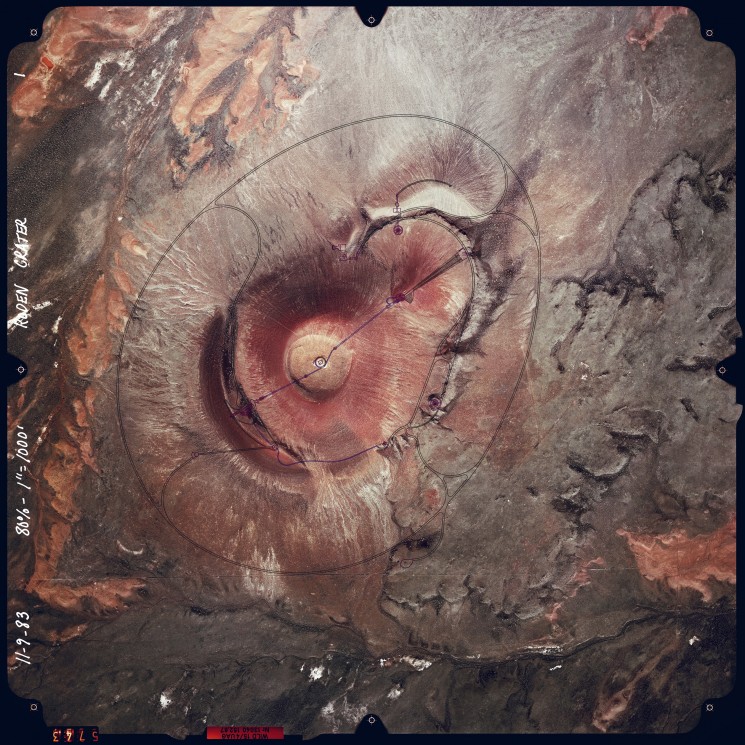
East Portal Images, photos by Florian Holzherr (image source)
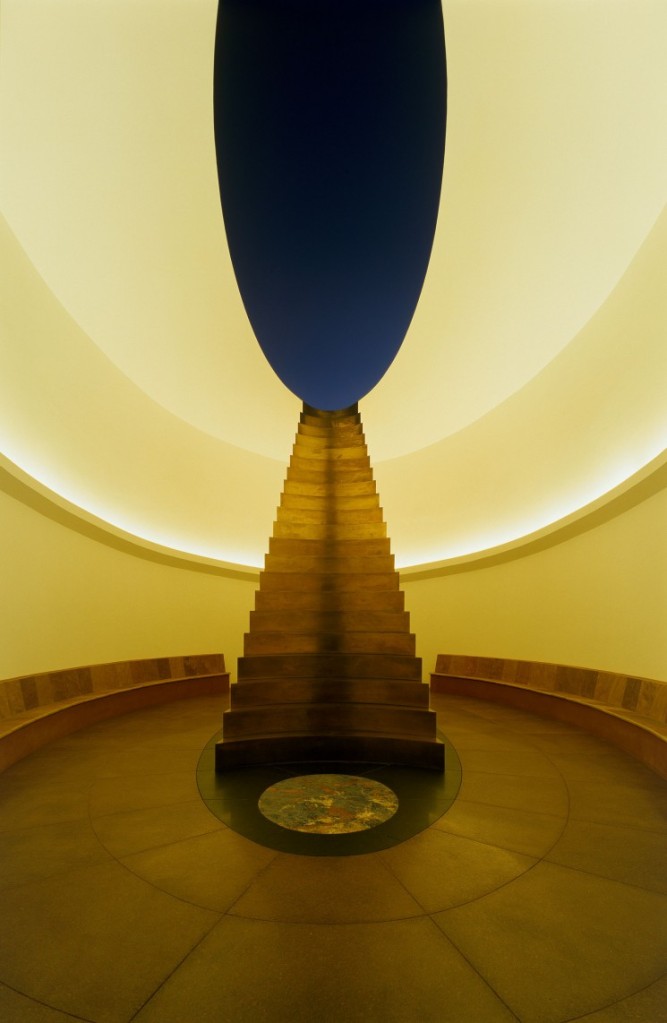
I think my friend summed it up best, as we were walking through the room with the large scale model of the 30 years in the making Roden crater project in Arizona, at the end of the exhibit: “It makes me so happy people like this exist. It’s inspiring.”


